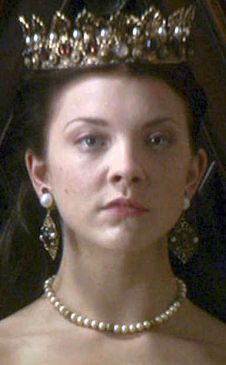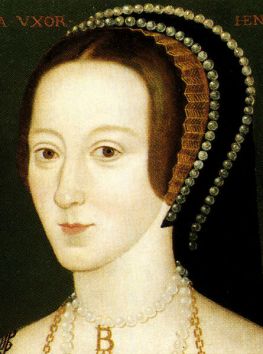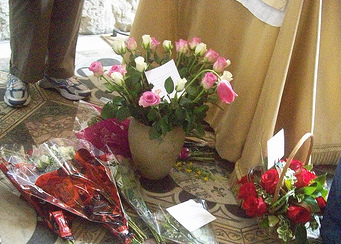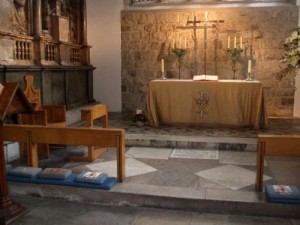Anne Boleyn - Historical profile - page 2
Jump to navigation
Jump to search
| Quotes about Anne's appearance: “beautiful and with an elegant figure” and “…eyes always most attractive which she knew well how to use with effect. Sometimes leaving them at rest and at others, sending a message to carry the secret witness of the heart. And, truth to tell, such was their power that many surrendered to their obedience” - Lancelot de Carles, a french contemporary poet “very eloquent and gracious, and reasonably good looking” - John Barlow, one of Anne's clerics “Very beautiful” - Francesco Sanuto, Venetian Diplomat “Young and good-looking” - "Original Letters" of Simon Grynee Even Nicholas Sander who was responsible for most of the negative comments about Anne, said : “She was handsome to look at, with a pretty mouth” Read more at: Anne Boleyn Controversies regarding her appearance
| ||||||||
| ||||||||
As a postscript, after King Henry VIII divorced Queen Katherine of Aragon (favourite daughter of Ferdinand and Isabella) and married Anne Boleyn, there was intense disgust in Spain, and to show their abhorrence, for years they carried round annually in procession a huge alligator (la tarasca, which means a serpent) and out of the back of this animal sprang a female figure signifying Anne Boleyn.This figure they called the "Anavolena" (the B and V being almost interchangeable in Spanish). The idea, of course, was that the Protestantism personified by Anne Boleyn sprang from a foul beast of slime. The tarasca is shown to the curious, with the Anavolena complete, in the hall of the "Gigantes" which is approached from the gallery round the cloisters of the cathedral, the most interesting one in Spain. | ||||||||
In November 1876, the remains below the altar in the chapel of St. Peter Ad Vincula in the Tower of London were investigated and a book by Doyne C. Bell about the discovery was published and below is an excerpt: | ||||||||
"the pavement was then lifted on the spot which was marked on the plan as the place of Queen Anne Boleyn's interment, and the earth removed to a depth of two feet; it had certainly not been disturbed for upwards of a hundred years. At this depth the bones of a female were found, not lying in the original order, but which had evidently for some reason or other been heaped together into a smaller space: all these bones were examined by Dr. Mouat, who at once pronounced them to be those of a female between twenty-five and thirty years of age, of a delicate frame of body, and who had been of slender and perfect proportions ; the forehead and lower jaw were small and especially well formed. The vertebrae were particularly small, especially one joint (the atlas), which was that next to the skull, and they bore witness to the Queen's "lyttel neck". He thought that these female bones had lain in the earth for upwards of three hundred years, and they were certainly all those of one person. No other female bones were found on this spot. Not much doubt existed in the minds of those present that these were the remains of Anne Boleyn, who is recorded to have been buried in front of the altar by the side of her brother George Rochford, and these being the first burials in the Chapel, the graves were in all probability dug to the right or dexter side of the altar, the so-called "place of honour". Rochford was buried on the 17th May, and the grave into which, at noon on the 19th May, the old elm chest containing the remains of his sister Anne was cast, was dug by the side of him.... [Memorandum by Dr. Mouat] The bones found in the place where Queen Anne Boleyn is said to have been buried are certainly those of a female in the prime of life, all perfectly consolidated and symmetrical, and belong to the same person. The bones of the head indicate a well-formed round skull, with an intellectual forehead, straight orbital ridge, large eyes, oval face and rather square full chin. The remains of the vertebrae, and the bones of the lower limbs, indicate a well-formed woman of middle height, with a short slender neck. The ribs show depth and roundness of chest. The hand and feet bones indicate delicate and well-shaped hands and feet with tapering fingers and a narrow foot. [NB. no mention of 6 fingers] They are all consistent with the published descriptions of the Queen and the bones of the skull might well belong to the person portrayed in the painting by Holbein, in the collection of the Earl of Warwick." For more read the entire book online : [of the Historic Burials in the Chapel of St. Peter ad Vincula in the Tower of London With an Account of the Discovery of the Supposed Remains of Queen Anne Boleyn"#v=onepage&q=&f=false|Notices of the historic persons buried in the chapel of St. Peter Ad Vincula ] |
In April, 1877, the remains found in the chancel of St. Peter Ad Vincula were reinterred “soldered up in thick leaden coffers, and then fastened down with copper screws in boxes made of oak plank, one inch in thickness. Each box bore a leaden escutcheon, on which was engraved the name of the person whose supposed remains were thus enclosed, together with the dates of death, and of the year (1877) of the reinterment....They were then placed in the respective positions in the chancel in which the remains had been found, and the ground having been opened, they were all buried about four inches below the surface, the earth was then filled in, and concrete immediately spread over them.” |
In 2006, a modern glass memorial by Brian Catling was unveiled with a glass pillow at the centre with these words etched around : “Gentle visitor pause a while, Where you stand death cut away death cut away the light of many days. Here, jeweled names were broken from the vivid thread of life. May they rest in peace while we walk the generations around their strife and courage, Under these restless skies.” |
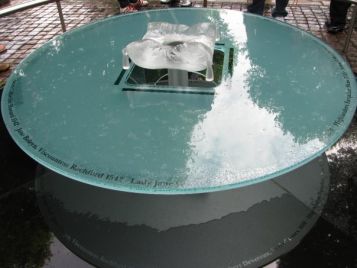 Tower of London Scaffold monument | 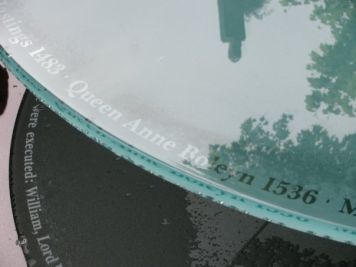 |
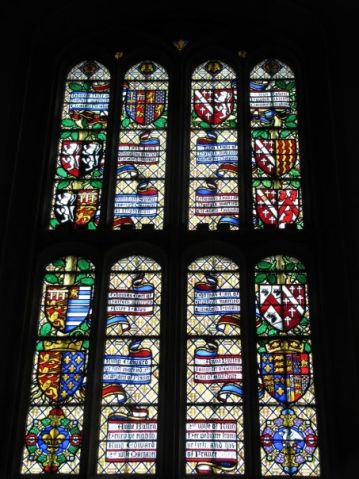 Hampton Court Palace Stained Glass Windows in the Apartment of Henry VIII | 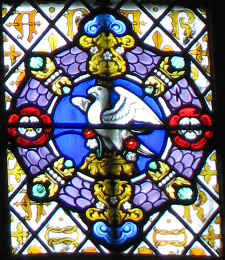 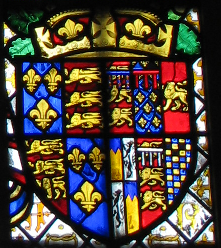 |
The Pedigree Window of Anne Boleyn, Queen of England 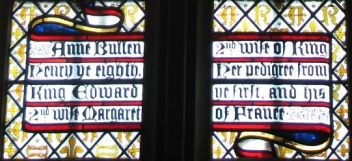 Anne Bullen, 2nd wife of King Henry ye eighth. Her pedigree from King Edward ye first and his 2nd wife Margaret of France. | 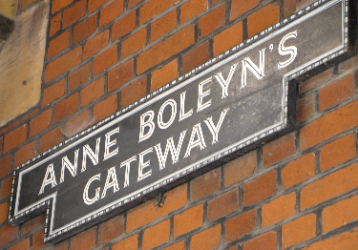 |
